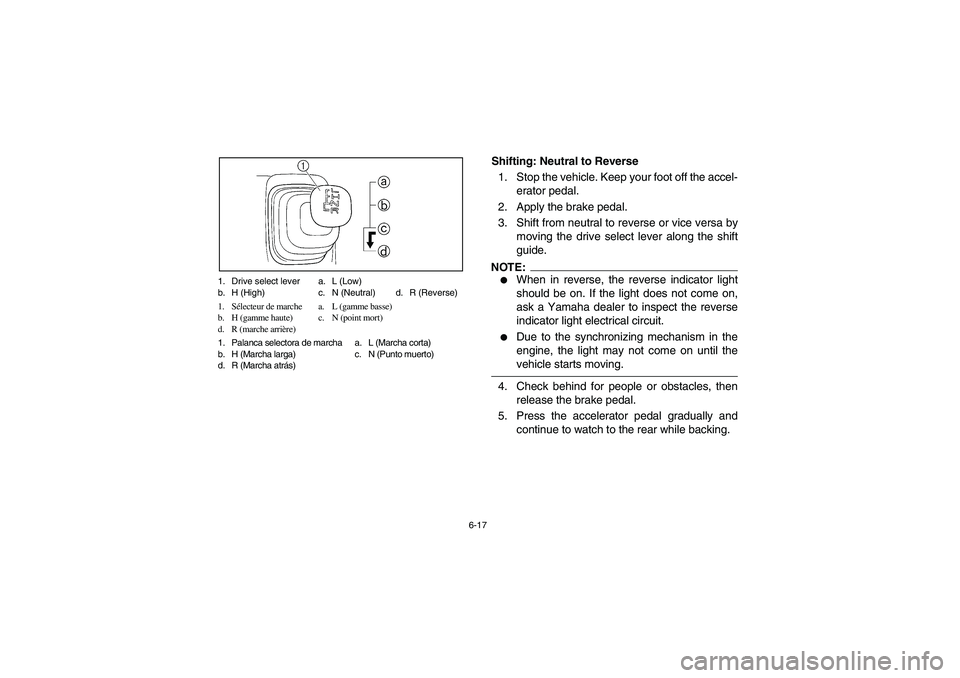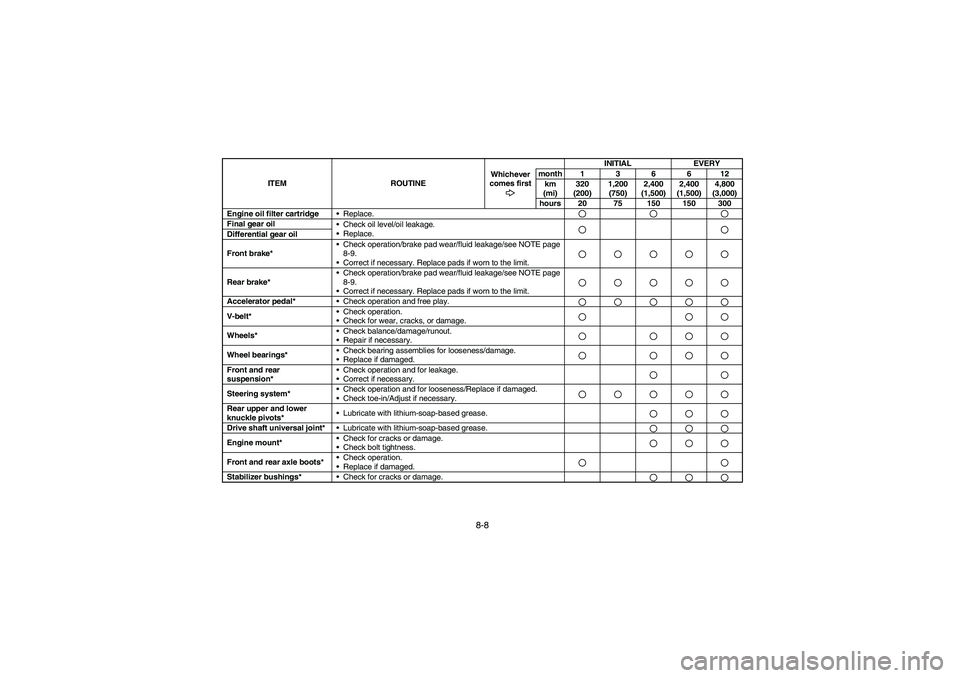Page 176 of 408
6-13
7. After the engine starts, disconnect the nega-
tive lead of the jumper cable from the vehicle
and charged battery, and then disconnect the
positive lead of the jumper cable from the
charged battery and the battery in the vehi-
cle.
8. Install the battery compartment cover.
9. Close the hood.
EVU00570
Warming up
To get maximum engine life, always warm up the
engine before starting off. Never accelerate hard
with a cold engine! To see whether or not the en-
gine is warm, check if it responds to the throttle
normally with the starter (choke) turned off.
U5UG61.book Page 13 Monday, September 6, 2004 9:00 AM
Page 180 of 408

6-17 1. Drive select lever a. L (Low)
b. H (High) c. N (Neutral) d. R (Reverse)
1. Sélecteur de marche a. L (gamme basse)
b. H (gamme haute) c. N (point mort)
d. R (marche arrière)
1. Palanca selectora de marcha a. L (Marcha corta)
b. H (Marcha larga) c. N (Punto muerto)
d. R (Marcha atrás)
Shifting: Neutral to Reverse
1. Stop the vehicle. Keep your foot off the accel-
erator pedal.
2. Apply the brake pedal.
3. Shift from neutral to reverse or vice versa by
moving the drive select lever along the shift
guide.NOTE:_ �
When in reverse, the reverse indicator light
should be on. If the light does not come on,
ask a Yamaha dealer to inspect the reverse
indicator light electrical circuit.
�
Due to the synchronizing mechanism in the
engine, the light may not come on until the
vehicle starts moving.
_ 4. Check behind for people or obstacles, then
release the brake pedal.
5. Press the accelerator pedal gradually and
continue to watch to the rear while backing.
U5UG61.book Page 17 Monday, September 6, 2004 9:00 AM
Page 212 of 408
7-11
Perform the Pre-Operation Checks on pages 5-1–
5-35. Set the parking brake, shift to neutral, and
follow the instructions on page 6-3 to start the en-
gine. Once it has warmed up and you have turned
the choke off, you are ready to begin driving your
vehicle. With the engine idling, shift the drive se-
lect lever into low or high. Then release the parking
brake. Press the accelerator pedal slowly and
smoothly. The centrifugal clutch will engage and
you will start to accelerate. Avoid higher speeds
until you are thoroughly familiar with the operation
of your vehicle.
When slowing down or stopping, take your foot off
the accelerator pedal and smoothly press the
brake pedal. Improper use of the brakes can
cause the tires to lose traction, reducing control
and increasing the possibility of an accident.
U5UG61.book Page 11 Monday, September 6, 2004 9:00 AM
Page 222 of 408
7-21
If you start to lose traction or momentum when
climbing, and you decide you will be unable to con-
tinue, use the brakes to come to a stop. Do not at-
tempt to turn the vehicle around. With your foot on
the brake, look behind you and plan your descent.
Shift the drive select lever in reverse so you can
use the engine brake if necessary to slow your de-
scent. Release the brake and begin to coast down
the hill. Use engine braking as much as possible,
gently applying the brakes when necessary.
GOING DOWNHILL
Check the terrain carefully before going down a
hill. When possible, choose a path that lets you
drive your vehicle straight downhill. Avoid sharp
angles that could allow the vehicle to pitch or roll
over. Carefully choose your path and drive no fast-
er than you will be able to react to obstacles that
may appear.
U5UG61.book Page 21 Monday, September 6, 2004 9:00 AM
Page 224 of 408
7-23
WARNING
Going down a hill improperly could cause loss
of control or cause the vehicle to overturn.�
Always check the terrain carefully before
you start down any hill.
�
Never go down a hill at high speed.
�
Avoid going down a hill at an angle that
would cause the vehicle to lean sharply to
one side. Go straight down the hill where
possible.
Before starting down hill, make sure the vehicle is
in low-range 4WD. On most slopes, this will let you
use engine braking to help you go downhill slowly.
Go as slowly as possible. If you are starting to go
too fast, apply the brakes gently. Avoid sudden ap-
plication of the brakes, which could cause the ve-
hicle to start sliding.
If you are sliding or skidding, try to steer in the di-
rection the vehicle is sliding to help you regain con-
trol.
U5UG61.book Page 23 Monday, September 6, 2004 9:00 AM
Page 246 of 408

8-7
EVU00670
PERIODIC MAINTENANCE/LUBRICATION
NOTE:�
For vehicles not equipped with an odometer or hour meter, follow the month maintenance intervals.
�
For vehicles equipped with an odometer or an hour meter, follow the km (mi) or hours maintenance in-
tervals. However, keep in mind that if the vehicle isn’t used for a long period of time, the month main-
tenance intervals should be followed.
ITEM ROUTINEWhichever
comes firstINITIAL EVERY
month136612
km
(mi)320
(200)1,200
(750)2,400
(1,500)2,400
(1,500)4,800
(3,000)
hours 20 75 150 150 300
Valves*Check valve clearance.
Adjust if necessary.
Cooling systemCheck coolant leakage.
Repair if necessary.
Replace coolant every 24 months.Spark plugCheck condition.
Adjust gap and clean.
Replace if necessary.Air filter elements
(Engine and air intake duct)Clean.
Replace if necessary.Every 20–40 hours
(More often in wet or dusty areas.)
Carburetor*Check idle speed/starter operation.
Adjust if necessary.Crankcase breather
system*Check breather hose for cracks or damage.
Replace if necessary.Exhaust system*Check for leakage.
Tighten if necessary.
Replace gasket(s) if necessary.Fuel line*Check fuel hose for cracks or damage.
Replace if necessary.Engine oil
Replace (warm engine before draining).U5UG61.book Page 7 Monday, September 6, 2004 9:00 AM
Page 247 of 408

8-8
Engine oil filter cartridge
Replace.Final gear oil
Check oil level/oil leakage.
Replace.Differential gear oil
Front brake*Check operation/brake pad wear/fluid leakage/see NOTE page
8-9.
Correct if necessary. Replace pads if worn to the limit.Rear brake*Check operation/brake pad wear/fluid leakage/see NOTE page
8-9.
Correct if necessary. Replace pads if worn to the limit.Accelerator pedal*
Check operation and free play.V-belt*Check operation.
Check for wear, cracks, or damage.Wheels*Check balance/damage/runout.
Repair if necessary.Wheel bearings*Check bearing assemblies for looseness/damage.
Replace if damaged.Front and rear
suspension*Check operation and for leakage.
Correct if necessary.Steering system*Check operation and for looseness/Replace if damaged.
Check toe-in/Adjust if necessary.Rear upper and lower
knuckle pivots*Lubricate with lithium-soap-based grease.Drive shaft universal joint*
Lubricate with lithium-soap-based grease.Engine mount*Check for cracks or damage.
Check bolt tightness.Front and rear axle boots*Check operation.
Replace if damaged.Stabilizer bushings*
Check for cracks or damage.
ITEM ROUTINEWhichever
comes firstINITIAL EVERY
month136612
km
(mi)320
(200)1,200
(750)2,400
(1,500)2,400
(1,500)4,800
(3,000)
hours 20 75 150 150 300
U5UG61.book Page 8 Monday, September 6, 2004 9:00 AM
Page 262 of 408
8-23
EVU00700
Engine oil and oil filter cartridge
The engine oil level should be checked before
each operation. In addition, the oil must be
changed and the oil filter cartridge replaced at the
intervals specified in the periodic maintenance and
lubrication chart.
To check the engine oil level
1. Place the vehicle on a level surface.
2. Remove the console. (See page 8-21 for
console removal and installation proce-
dures.)
3. Start the engine, warm it up for several min-
utes, and then turn it off.
4. Wait a few minutes until the oil settles.
U5UG61.book Page 23 Monday, September 6, 2004 9:00 AM